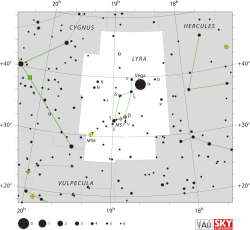Gamma Lyrae
| Observation data Epoch J2000 Equinox J2000 |
|
|---|---|
| Constellation | Lyra |
| Right ascension | 18h 58m 56.62241s |
| Declination | +32° 41′ 22.4003″ |
| Apparent magnitude (V) | 3.261 |
| Characteristics | |
| Spectral type | B9 III |
| U−B color index | –0.125 |
| B−V color index | –0.047 |
| Astrometry | |
| Radial velocity (Rv) | –21.1 km/s |
| Proper motion (μ) |
RA: –3.09 mas/yr Dec.: +1.11 mas/yr |
| Parallax (π) | 5.26 ± 0.27mas |
| Distance | 620 ± 30 ly (190 ± 10 pc) |
| Details | |
| Radius | 15 R☉ |
| Surface gravity (log g) | 3.5 cgs |
| Temperature | 10,080 K |
| Metallicity [Fe/H] | +0.11 dex |
| Rotational velocity (v sin i) | 71–72 km/s |
| Other designations | |
Gamma Lyrae (γ Lyrae, abbreviated Gamma Lyr, γ Lyr), also named Sulafat, is the second brightest star in the northern constellation of Lyra. With an apparent visual magnitude of 3.3, it is readily visible to the naked eye. Parallax measurements yield an estimated distance of 620 light-years (190 parsecs) from the Sun.
γ Lyrae (Latinised to Gamma Lyrae) is the star's Bayer designation.
It bore the traditional names Sulafat (Sulaphat), from the Arabic السلحفاة al-sulḥafāt "turtle", and Jugum, from the Latin iugum "yoke". The connection with turtles is that fine harps were traditionally made of tortoiseshell. In 2016, the International Astronomical Union organized a Working Group on Star Names (WGSN) to catalogue and standardize proper names for stars. The WGSN approved the name Sulafat for this star on 21 August 2016 and it is now so entered in the IAU Catalog of Star Names.
In China, 漸台 (Jiāntāi), meaning Clepsydra Terrace, refers to an asterism consisting of this star, Delta2 Lyrae, Beta Lyrae and Iota Lyrae. Consequently, Gamma Lyrae itself is known as 漸台三 (Jiāntāisān, English: the Third Star of Clepsydra Terrace.)
...
Wikipedia

